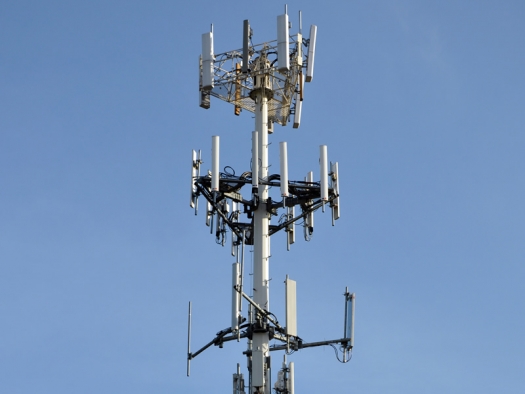CellPhoneTower.jpg

Photo by Joe Ravi, ©2011 / CC-BY-SA 3.0
The potential risks of EMR were debated decades ago, when children who were raised near high-voltage power lines were thought to have a higher incidence of leukemia. Studies eventually proved a solid link between the EMR given off by those power lines and childhood leukemia, but the debate flared up again when cell phones came onto the scene and the incidence of brain cancer seemed higher in cell phone users. Eventually, studies demonstrated real, dire health risks.
Scientists used to believe that the only radiation that posed a health risk was what's called thermal radiation, which is radiation with energy high enough to heat up the tissues. The EMR from power lines, cell phones, cordless phones, Wi-Fi computer systems, TV and computer monitors, appliances, bedside digital clock radios, blow dryers, and other electronics is too low to heat tissues, so it's called subthermal. Taking its cue from the scientific community, the U.S. government declared EMR to be safe. Now we know better. In fact, according to many scientists, subthermal EMR (now called electropollution) may turn out to be one of our worst environmental health hazards. It has been linked to such diseases as leukemia, brain tumors, inner ear tumors, Lou Gehrig's disease, Alzheimer's disease, breast cancer, accelerated aging, and depression.
How Electropollution Harms
Every single cell in the human body is encased in a cell membrane. The cell membrane is studded with receptors that decide what can enter the cell (such as nutrients that act as fuel) and what can leave (such as the waste products of metabolism). The movement of chemical "messengers" such as sodium ions and calcium ions into and out of cells is also how cells communicate with each other. Intercellular communication governs every single bodily function. It alerts the immune system when a pathogen invades, for example.
And it tells the brain when carbon dioxide in the blood has gotten too high and it's time to inhale. Manmade electropollution, which easily penetrates our tissues, is completely foreign to our cells. Cell membranes respond precisely how they should when invaded by something foreign: They shut down, allowing nothing in or out. This is called the cellular stress response, and it cuts the affected cell off from communication with the rest of the body. With the cell on lockdown, toxins and wastes can't get out and nutrients can't get in. Free radicals accumulate inside the cell, cellular energy declines, and the stage is set for premature aging, degenerative diseases, DNA damage, and cancer-causing mutations, all from electropollution that's way below current government-set "safety" limits (May 2009, Bioelectromagnetics).
Electropollution is also an endocrine disruptor, interfering with the secretion and action of several hormones, including melatonin, which is secreted by the pineal gland. In addition to regulating the sleep/wake cycle, melatonin is one of the body's most powerful natural antioxidants and free-radical scavengers, and it strengthens the immune system's ability to fight cancer. In addition, melatonin inhibits the release of estrogen, thereby suppressing estrogen-sensitive cancers such as breast cancer. It also makes breast cancer chemotherapy work better and softens chemo's side effects, plus it directly stops breast cancer cells from growing. On top of all that, studies show that melatonin improves thyroid function.
Electropollution interferes with all of these functions. In fact, in the laboratory, breast cancer cells that had stopped growing because they had been treated with melatonin started growing again when exposed to electropollution. As a result, women in jobs with high electropollution, such as electrical engineers, mainframe computer technicians, telephone installers, and power line workers, are at higher risk of dying from breast cancer. And men with those jobs have a breast cancer risk that's six times higher than in the general male population. And, regardless of career, after 10 years of cell phone use, the risk of certain brain cancers for both sexes doubles (December 2007, Biomedicine & Pharmacotherapy; March 2009, Surgical Neurology).
Electro-Protection
So how can you protect yourself from electropollution and its harmful effects? Unfortunately, government regulations don't protect you because they're based on outdated science. And it's now impossible to avoid electropollution, even if you never use a cell phone or computer.
Cell phone towers are everywhere. WiFi computer systems flood our airports, coffee shops, highway rest stops, stores, public libraries, schools, hospitals, and private households with radio frequency radiation.
Satellite TV and Internet bombard most communities, and the average person carries a growing array of electronics during the day and sleeps perilously close to them every night. These layers of exposure are believed to have cumulative physical effects.
Luckily, you can minimize your exposure and help repair the damage that has already taken place by doing the following things:
Lifestyle Factors
- Use your cell phone only when necessary, turn it off when not in use, and never carry it on your person. Its electropollution irradiates everything within six or seven inches. In fact, men who carry cell phones on their belts have a 30 percent lower sperm count (May 2009, Bioelectromagnetics).
- Don't use a wireless headset with your cell phone. It increases brain-damaging, cancer-causing radiation by as much as threefold (May 2009, Bioelectromagnetics). Instead, use the speakerphone feature.
- Don't keep wireless or cordless devices in the bedroom. That includes cell phones, cordless phones, Blackberries, and laptop computers.
- Move wired devices, such as digital clock radios and CD players, away from your bed. Also, position your bed as far as possible from wall outlets and wires inside the wall.
- If at all possible, don't live near (and certainly not under) high power lines, especially if children live with you. Studies show a 500 percent increased lifetime cancer risk among children who live within 300 meters of such lines during their first five years. And with adult exposure, there's a higher risk of malignant melanoma and leukemia.
Nutritional Support
- Take supplemental melatonin to counteract the suppression of pineal gland secretion. I recommend 300 mcg to 3 mg every evening, half an hour before bedtime.
- Take supplemental vitamins C and E, which, according to early studies, significantly decrease tissue damage caused by cell phones (August 2007, Toxicology and Industrial Health). I recommend daily dosages of at least 1-2 grams of mineral buffered vitamin C (in divided doses) and 800 IU of vitamin E.
- Take honeybee propolis, a rich source of the potent free-radical scavenger and antioxidant caffeic acid. In lab rat studies, caffeic acid significantly protected against cell phone-induced damage to heart and kidney tissue (October 2005, Toxicology and Industrial Health; August 2005, Molecular and Cellular Biochemistry). I recommend 500-1,000 mg of propolis twice daily. I like YS Organic Bee Farms Propolis, which is available at www.vitacost.com.
- Increase your intake of apples, turnips, radishes, cauliflower, bok choy, arugula, kale, and cabbage, all of which are good sources of caffeic acid.
- Take Ginkgo biloba. After seven days' exposure to cell phones, the oxidative damage to brain tissue in control rats was significant, and their natural brain tissue antioxidant levels were depleted. But in rats pretreated with Ginkgo biloba, brain damage was prevented and natural brain antioxidant levels were preserved (February 2004, Clinica Chimica Acta). I recommend 60-120 mg daily.
- Take supplemental zinc. It is known to protect against a cell membrane-damaging process known as lipid peroxidation, which electropollution causes in brain tissue. In laboratory rats exposed to electropollution for five minutes every other day for six months, plasma zinc levels significantly dropped (February 2006, Tohoku Journal of Experimental Medicine). I recommend 15 mg daily.
BIOPRO-tection
Consider installing BIOPRO chips onto your cell phone, computer, and other electronic devices and household appliances. Their patented Molecular Resonance Effect Technology (MRET) provides an invisible shield against low-energy electropollution by emitting frequencies that neutralize it and resonate with the human electromagnetic field.
When human blood samples were exposed for 15 minutes to cell phones that did not have MRET shielding, the distribution of white blood cells in the samples shifted to a typical stress response. When samples were exposed with shielded cell phones, their white blood cells shifted in the opposite direction, to a distribution that indicated even less stress than in the control samples that were not exposed to any cell phone radiation at all (July-August 2008, Explore!). You can learn more at Gia Wellness (formerly called Biopro).
Remember, electropollution is everywhere, but you can protect yourself with the tips I've provided for you here. I wish you the best of health!


